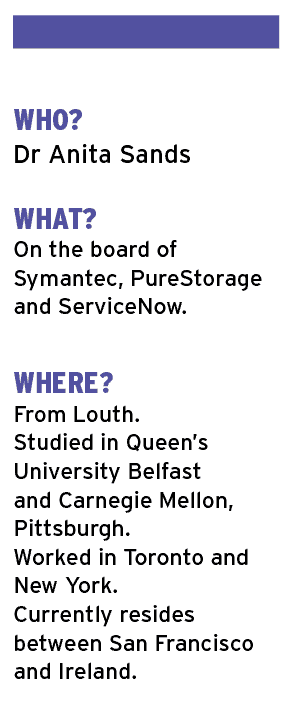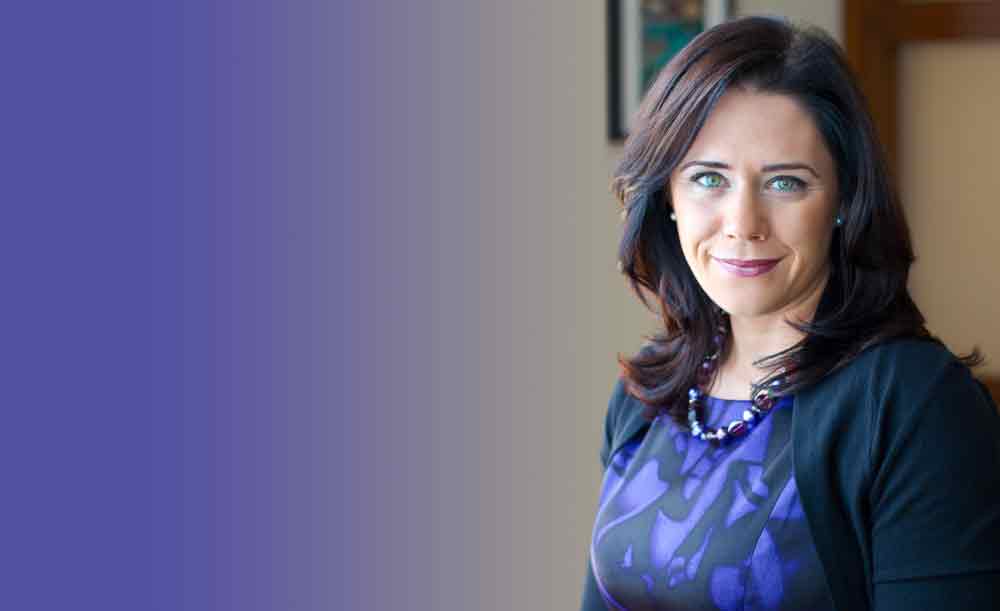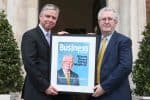Professional board director Anita Sands has made clever strategic career pivots and overcome Silicon Valley sexism to stake her claim at the top table, writes Deanna O’Connor.
 It’s easy to look back when you see how certain strands have come together and think ‘ah, there was a plan all along’. Speaking to Anita Sands, it seems the threads of her life have woven together in a very pleasing pattern. While it may not have been a strategic thought process that led her to engage in debate and public speaking competitions while in school – rather, it was the encouragement of good teachers – her commitment to keeping up the training throughout her college and early career years has resulted in a confident and articulate manner, invaluable for making an impression on the conference speaker circuit or being taken seriously in the boardroom.
It’s easy to look back when you see how certain strands have come together and think ‘ah, there was a plan all along’. Speaking to Anita Sands, it seems the threads of her life have woven together in a very pleasing pattern. While it may not have been a strategic thought process that led her to engage in debate and public speaking competitions while in school – rather, it was the encouragement of good teachers – her commitment to keeping up the training throughout her college and early career years has resulted in a confident and articulate manner, invaluable for making an impression on the conference speaker circuit or being taken seriously in the boardroom.
“You should be investing in the core skills that you need, behind the scenes,” she asserts, “whether you’re a world-class athlete or a world-class executive. That’s the singular most valuable thing I ever did – it’s particularly valuable for women because one of the things that I’ve observed over the years is that women have a tendency not to speak up, so I tell young women all the time: ‘find your voice and find it early’. It’s not enough for us to have a seat at the table, it’s not enough for us to lean in, we have to lean in and speak up.”
Although Anita first studied in the sciences, she had a eureka moment that led her down a very different path. Her first strategic career pivot, away from the world of physics and towards her master’s in public policy, had been engendered by the realisation that people who could speak both languages – that of science and academia and that of lobbying and public policy – were few and far between. Thus came the far-sighted realisation that someone like her would be essential in order to bridge that gap in a world quickly becoming more and more heavily dependent on science and technology.
That pivot was simple and quick – pick up a few scholarships, make lifelong friends with one of the key historical figures of our times (more on which later)… then hand in your PhD on a Friday in Belfast and by Monday be in Pittsburgh at a lecture on urban economic development with Richard Florida, the author of The Rise of the Creative Class.
A graduate of the Carnegie Mellon master’s in public policy, she doesn’t rule out a public service role either were she to return to Ireland full time. When I tease her about the ‘Anita for President’ campaign, she latches on to the fact that Irish female presidents Mary Robinson and Mary McAleese were hugely inspirational to her in her youth. ‘Mocking is catching,’ I think. She’d get my vote, were she to run for it. Impressively well-educated, with a PhD in atomic and molecular physics from Queen’s University to her name, she is also blessed with that most engaging quality of total normality; a down-to-earth pragmatic manner. Speaking with her you get the sense that she has that engaging quality of comfortably chatting to anyone, at any level of society.
CAREER GUIDANCE
Indeed, at the tender age of 27 she was on the receiving end of a career guidance session from the then-Tánaiste Mary Harney. It was a meeting organised by TK Whitaker – who had been so impressed by Anita during the application process for the Fulbright Scholarship, for which he chaired the board/committee, that they had kept up written correspondence.
“I thought this was the most intimidating, overwhelming idea that I would go to the Tánaiste and ask her for her advice but to her credit upon request from TK Whitaker she took the meeting with me,” Anita recalls.
“I explained my circumstances and I told her that I was interested in coming back to Ireland and working in the public sector and so forth, and she strongly encouraged me to get some global and international experience under my belt so that when I came back here I would be in a position to be able to influence and impact things to a much greater degree.
I thought it was so odd that the Tánaiste was telling somebody interested in public policy to not come home
“I thought it was so odd that the Tánaiste was telling somebody interested in public policy to not come home immediately,” she muses, “but I now look back on that conversation as being one of the most pivotal conversations of my career, not only because I’ve ended up having a phenomenal career internationally in Canada and in the US, but Mary Harney was right. I have been able to get involved in things here – whether it’s through Enterprise Ireland or the IDA or various other entities – and support the economy, support companies, support entrepreneurs, and I can bring so many more resources and, honestly, better perspective to that effort than I could have if I had come home.”
It has been an international career that took her first to Toronto and then to New York, working in the financial services sector for a decade and specialising in enterprise transformation and technology-led innovation.
Previous roles include transformation consultant, COO, group managing director and head of change leadership with UBS Financial Services. She also held the post of managing director and head of transformational change at Citi Group, and the senior vice-presidency of innovation and process design at Royal Bank of Canada.
TURNING TO TECH
It was during the years of the financial crisis that her interest turned more and more towards tech and she decided it was time to make another crucial pivot.
This was spurred on by her love of innovation and technology. She recounts: “All of the jobs that I’d had in financial services were all about driving technology and innovation and enterprise-wide transformation. During the good times in the financial services industry that was code for digital disruption; bringing in emerging technologies. During the tough times in the financial crisis it was code for cutting costs as quickly and efficiently as you could, so I got to see both sides of the coin.”
All of the jobs that I’d had in financial services were all about driving technology and innovation and enterprise-wide transformation
When the financial crisis receded she was working for Swiss bank UBS, and found in the aftermath that a lot of their discretionary tech budgets were going into dealing with regulatory change, new compliance, and a whole new approach to risk management. “And meanwhile I’m looking at Silicon Valley and the rise of mobile, social, cloud, big data and we just don’t have the capacity or the funding and yet there’s so much happening out there,” she recalls. It was this longing to play a greater part in new and exciting innovations that led her to decide it was time for another major change in her life.
The pivot towards the tech scene, and the planned move from east to west coast, hit a bump in the road when life and love had other plans for her – and what was originally a simple single person’s career move suddenly had a new husband and five stepchildren added into the mix. A new baby followed soon after.
SILICON & SEXISM
Settling into the Silicon Valley scene may not have been without its difficulties, but these were nothing she hadn’t encountered before. Silicon Valley sexism has been hitting the headlines this year, with the scandals at Uber and that controversial leaked 10-page memo by a now-fired Google employee arguing for less emphasis on gender diversity in the workplace.
She recalls: “I remember sitting at a board director’s dinner in Silicon Valley and this extremely prominent Silicon Valley icon – I couldn’t believe I was lucky enough to get seated beside him – and he turned around halfway through the dinner and said ‘I wonder how you made it this far looking the way you do?’ and I said ‘What do you mean by that?’ and looking straight at me he said, ‘With all those curves,’ as he stared directly at my chest. And I said ‘Lucky thing was the curves came with a hell of a great brain and an even better personality.’ And he smiled. In some ways guys like that, even at my level, are testing you to see how you handle that. They’re testing reactions. And again I think one of the great advantages of being Irish is you can get away from situations like that with a little bit of pointed humour, so it’s not overtly aggressive but it’s enough to know your comment wasn’t appreciated. He won’t make a comment like that to me again.
In some ways guys like that, even at my level, are testing you to see how you handle that. They’re testing reactions.
“I honestly believe right now: these comments along the way create a situation where you don’t feel like you belong,” she continues. “Another example I like to use is the use of American sports analogies to describe absolutely every business scenario. In Silicon Valley I used to struggle all the time because people would use these baseball analogies and I really had no idea what they meant. Sometimes I could guess but sometimes I was getting the interpretation wrong. It’s not gender at all – it’s a micro behaviour that’s exclusionary.
“I was making this point at a conference in Silicon Valley and there were a lot of people there who were on visas and non-Americans and they all started to laugh. Then I noticed the guy sitting beside me who had spoken before me had used a ton of baseball analogies – they were going to swing for the fences and bat it out of the park and hit singles and doubles. He was embarrassed because he thought he was making this great rallying inspiring speech but to an audience that’s 50 per cent non-American that’s just not going to be as impactful. It goes back to that public speaking training of know your audience.”
THE IRISH ADVANTAGE
For Anita, the future of tech in Ireland is a very interesting topic. When we met, she was sitting at lunch with Kingsley Aikins, the noted diaspora expert and long-standing friend.
“I’m sensitive to the fact that when you are an émigré you are an insider on the country’s past and a stranger to its present. In that period of 17 years since I left there has been such dramatic change,” she muses. “Kingsley was saying that 17 per cent of the Irish population right now was not born in Ireland, and it’s something like 24 or 25 per cent of the Dublin population was not born in Dublin. It’s a whole different country.”
Ireland’s greatest balance is off the books; it’s in the power of our connections and our ability to connect
She stresses a point they had just been discussing: that every person who is from Ireland working abroad, or even who has worked in Ireland and gives glowing reviews of their experience here, is an important ambassador for our country and the tech scene here.
She recounts a tale from tough times during the financial crisis where she had to cut the Citi Global workforce significantly across the world. “Dublin was our fifth most expensive location globally and it’s hard to justify keeping a big headcount in the fifth most expensive location… I had a guy walk into my team, one of the top chief technology officers, and he said ‘Anita I’m begging you – please don’t make me cut my people in Dublin… I’ll cut seven heads anywhere else in the world for one head in Dublin.’ He told me that he couldn’t get the combination of design skills and creativity with this attitude of ‘ah sure we’ll just get it done.’ He said the Irish are the best problem-solvers; they always just figure out a way to get things done.”
Anita recognises an Irish advantage, outlining why she believes “the Irish are the most special people in the world” – “I think we are a mix of left and right brain, a mix of work ethic and creativity, a mix of personality and curiosity”.
“The world is a very interconnected and highly competitive place,” she recognises, “so we have to leverage any advantage that we have, and the fact that we can tap into a network of fellow countrymen or people that are supportive of all things Irish, that is an asset. Ireland’s greatest balance is off the books; it’s in the power of our connections and our ability to connect.”
BOARD UP
Speaking of the future, Sands has plenty of plans and tells me: “Now all that great personal trajectory of the last few years has settled down, I’m ready to ramp back up to full-time capacity.” Full capacity for her would be a maximum of four public boards: “I think to do the job very well that’s about the right number – and maybe a couple of private boards, maybe some more advisory work.”
Being a board director is a role she finds immensely satisfying, she says. “It’s just such fascinating work. I used to say that when I was in an operating role I had the advantage of learning from one CEO, and as a young new board director I’m sitting in these rooms with ten CEOs around me and you’re getting to see how they think about strategy, how they deal with crises, how they handle boardroom dynamics, management dynamics, how you think about hiring and firing a CEO, and it was just like an MBA in the boardroom.
“I happen to have had, just by virtue of the companies I’ve been working with, a very interesting four years doing this, where I’ve encountered a lot of things – major divestitures, several CEO successions, major acquisitions, activism – so I think I’ve handled pretty much everything you can handle as a board director except bankruptcy, and I’m good with that!”







